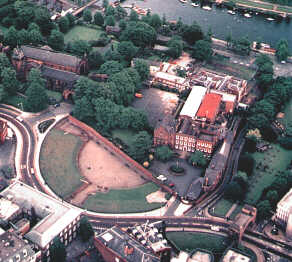
These web pages present several years' research into the archaeology of one of Chester's best known historical monuments. They summarise what is known about the site and pose questions that remain to be answered in the light of changes in our understanding of amphitheatres since the major excavations that took place here in the 1960s.
What you will read here is very much work in progress. At a time when the amphitheatre is once again the focus of public attention, we hope to show that archaeologists are still trying to find out more about the site and to work out the best ways of answering those questions that we are now posing.
Chester's amphitheatre lies immediately outside the southeastern corner of the Roman legionary fortress of Deva at NGR SJ 4085 6614. It is one of the best known and substantial archaeological monuments in the city. The northern (exposed and displayed) part is currently managed by the City Council through an agreement with English Heritage, whilst much of the remainder lies beneath the Dee House site, which is owned by the City. As the body responsible for providing archaeological expertise and advice to the City, Chester Archaeology has prepared the following research agenda. The agenda is intended to inform and set the context for developing further research, investigation, interpretation and enhancement of the site.
Given the public perception of Chester as a Roman site, any visible Roman monument has enormous interpretative potential. In the case of the amphitheatre, this is particularly strong. Not only is it currently the largest visible Roman monument in the city, although only about 45% has been excavated and displayed, but it is also beside one of the main routes into the city. In addition, there is the romantic (if historically debatable) association of amphitheatres with gladiatorial combats, public spectacles and throwing Christians to the lions. As physical evidence for Roman civilisation, it has the resonance of the Roman mob's fabled clamouring for panem et circenses ('bread and circuses') in Juvenal's well-known phrase (Satire X.81).

This document forms part of the research programme within the broader research framework of Chester Archaeology (currently undergoing revision). It is structured following the hierarchy of elements set out by Olivier (1996, 5). Reference has also been made to a number of earlier research documents (including Thomas 1983; SPRS 1985; Chester Archaeological Service 1994).
The site is a Scheduled Ancient Monument (reference number Cheshire 85) and it is recognised that any interventional research will require Scheduled Monument Consent. Nevertheless, there are many opportunities for fruitful research that would involve no interventional work whatsoever.
On to the modern history of the amphitheatre and its discovery.